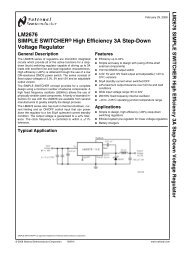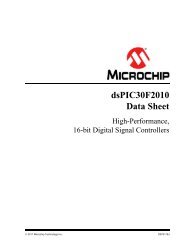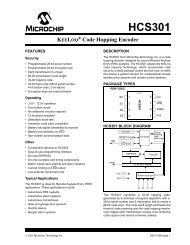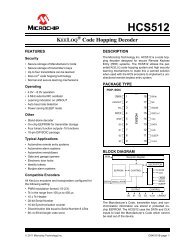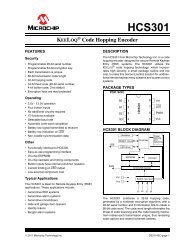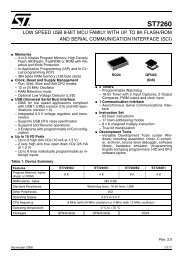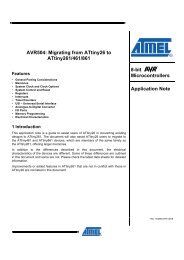Create successful ePaper yourself
Turn your PDF publications into a flip-book with our unique Google optimized e-Paper software.
<strong>STM32W108C8</strong><br />
Analog-to-digital converter<br />
11 Analog-to-digital converter<br />
The <strong>STM32W108C8</strong> analog-to-digital converter (ADC) is a first-order sigma-delta converter<br />
with the following features:<br />
● Resolution of up to 12 bits<br />
● Sample times as fast as 5.33 µs (188 kHz)<br />
● Differential and single-ended conversions from six external and four internal sources<br />
● Two voltage ranges (differential): -VREF to +VREF, and –VDD_PADS to +VDD_PADS<br />
●<br />
●<br />
Choice of internal or external VREF: internal VREF may be output<br />
Digital offset and gain correction<br />
● Dedicated DMA channel with one-shot and continuous operating modes<br />
Figure 49 shows the basic ADC structure.<br />
Figure 49.<br />
ADC block diagram<br />
While the ADC Module supports both single-ended and differential inputs, the ADC input<br />
stage always operates in differential mode. Single-ended conversions are performed by<br />
connecting one of the differential inputs to VREF/2 while fully differential operation uses two<br />
external inputs.<br />
Note:<br />
In high voltage mode, input buffers (with 0.25 gain only) may experience long term drift of its<br />
input offset voltage that affects ADC accuracy. In these cases, only the 1.2V input range<br />
mode of the ADC should be used. If measurement of signals >1.2V is required, then<br />
external attenuation should be added.<br />
Doc ID 018587 Rev 2 160/215





